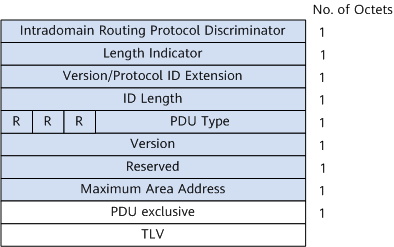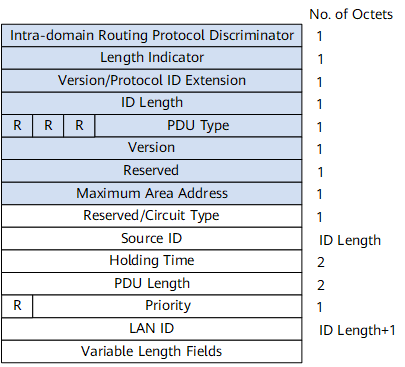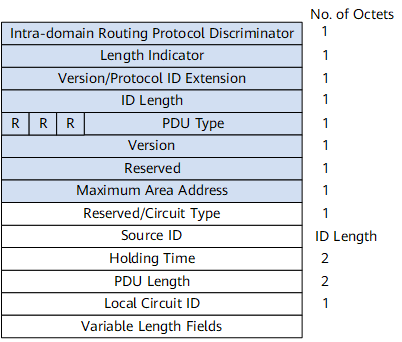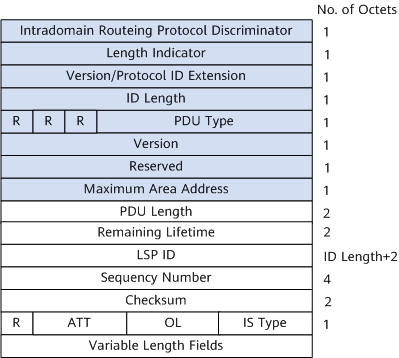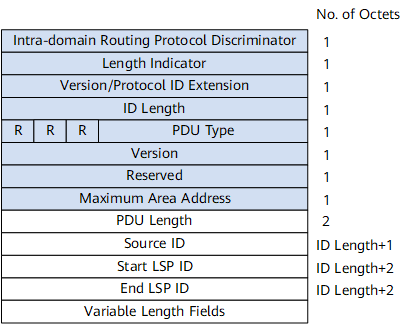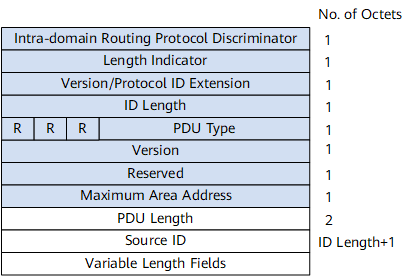IS-IS Control Messages
IS-IS routers implement routing by exchanging control messages. This section describes IS-IS control messages.
IS-IS PDU Formats
Nine types of IS-IS protocol data units (PDUs) are available for processing control information. Each PDU is identified by a 5-digit type code. All PDUs can be classified into three types: Hello, LSP, and SNP, as shown in Table 1.
PDU Type |
Acronym |
Type Value |
|---|---|---|
Level-1 LAN IS-IS Hello PDU |
L1 LAN IIH |
15 |
Level-2 LAN IS-IS Hello PDU |
L2 LAN IIH |
16 |
Point-to-Point IS-IS Hello PDU |
P2P IIH |
17 |
Level-1 Link State PDU |
L1 LSP |
18 |
Level-2 Link State PDU |
L2 LSP |
20 |
Level-1 Complete Sequence Numbers PDU |
L1 CSNP |
24 |
Level-2 Complete Sequence Numbers PDU |
L2 CSNP |
25 |
Level-1 Partial Sequence Numbers PDU |
L1 PSNP |
26 |
Level-2 Partial Sequence Numbers PDU |
L2 PSNP |
27 |
- Intradomain Routing Protocol Discriminator: network layer protocol identifier. In IS-IS, the value is 0x83.
- Length Indicator: length of the fixed header.
- ID Length: length of a system ID.
- PDU Type: type of a PDU. For details, see Table 1.
- Maximum Area Address: maximum number of area addresses supported by an IS-IS area. Currently, this field has a fixed value of 0, indicating that a maximum of three area addresses are supported.
- Type/Length/Value (TLV): Different types of PDUs contain different TLVs, as shown in Table 2.
Table 2 Mapping between TLV codes and PDU types TLV Code
TLV Code Name
PDU Type
1
Area Addresses
IIH, LSP
2
IS Neighbors (LSP)
LSP
4
Partition Designated Level2 IS
L2 LSP
6
IS Neighbors (MAC Address)
LAN IIH
7
IS Neighbors (SNPA Address)
LAN IIH
8
Padding
IIH
9
LSP Entries
SNP
10
Authentication Information
IIH, LSP, or SNP
128
IP Internal Reachability Information
LSP
129
Protocols Supported
IIH or LSP
130
IP External Reachability Information
L2 LSP
131
Inter-Domain Routing Protocol Information
L2 LSP
132
IP Interface Address
IIH or LSP
Hello Packet Format
- Hello packets on a broadcast network: Figure 2 shows the format of a Hello packet on a broadcast network.
- Hello packets on a P2P network: Figure 3 shows the format of Hello packets on a P2P network.
As shown in Figure 3, most fields in a P2P IIH are the same as those in a LAN IIH. The P2P IIH does not have the priority and LAN ID fields but has a local circuit ID field. The local circuit ID indicates the local link ID.
LSP Format
LSPs are used to exchange link-state information. There are two types of LSPs: Level-1 and Level-2. Level-1 IS-IS transmits Level-1 LSPs. Level-2 IS-IS transmits Level-2 LSPs. Level-1-2 IS-IS can transmit both Level-1 and Level-2 LSPs.
The two types of LSPs have the same format, as shown in Figure 4.
The main fields are as follows:
ATT: Attached bit
ATT is generated by a Level-1-2 router to identify whether the originating router is connected to other areas. When a Level-1 router receives a Level-1 LSP with ATT as 1 from a Level-1-2 router, the Level-1 router generates a default route destined for the Level-1-2 router so that data can be transmitted to other areas.
Although ATT is defined in both the Level-1 LSP and Level-2 LSP, it is set only in the Level-1 LSP only by the Level-1-2 router.
OL: LSDB overload
LSPs with the OL bit set are still flooded on the network, but these LSPs are ignored during calculation of the routes that pass through the router that sets the OL bit. That is, after a router is configured with the overload bit, other routers ignore the router when performing the SPF calculation except for the direct routes of the router.
IS Type: type of the IS-IS generating the LSP
It is used to specify whether the IS-IS type is Level-1 or Level-2 (01 indicates Level-1 and 11 indicates Level-2).
SNP Format
CSNPs carry summaries of all LSPs in LSDBs, which ensures LSDB synchronization between neighboring routers. On a broadcast network, the designated intermediate system (DIS) sends CSNPs at an interval. The default interval is 10 seconds. On a P2P link, neighboring devices send CSNPs only when a neighbor relationship is established for the first time.
Figure 5 shows the CSNP format.
The main fields are as follows:
Source ID: system ID of the router that sends SNPs
Start LSP ID: ID of the first LSP in a CSNP
End LSP ID: ID of the last LSP in a CSNP
PSNPs list only the sequence numbers of recently received LSPs. A PSNP can acknowledge multiple LSPs at a time. When LSDBs are asynchronous, PSNPs are also used to request a new LSP from a neighbor.
Figure 6 shows the PSNP format.
